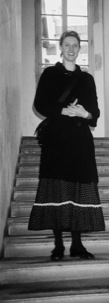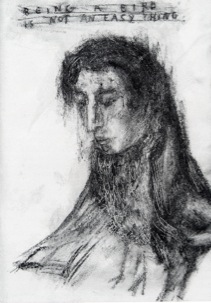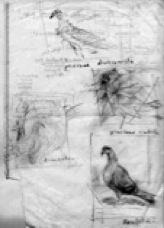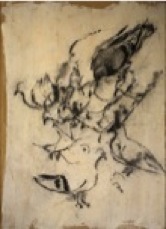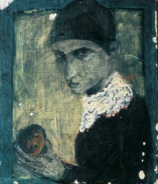Giuliana Videtta, art historian, Florence, Italy 2005
Of Being is a Bird
The likest to the Down
Emily Dickinson, (Complete Poems, 653, c. 1862)
Perhaps I have not learned to love pigeons, but I have learned to look at them with different eyes.
Especially when it has rained and their clean red feet are reflected in the puddles in Piazza Indipendenza
and their feathers reveal magnificent, iridescent colours now that the sunlight has noticed them.
These are some reflections on Beauty shared with Tjaarke Maas while we were preparing her exhibition in Florence in 1999.
I met her on that occasion, and continued to follow her work. Our meetings are vivid and present, as are her words, even now she is no longer with us.
Her death at the age of thirty, in circumstances that are still obscure (an untimely death, not unusual among artists, at least in the Western tradition), seems to oblige anyone who sets out to write about her work to sum up a story, to recount her life as if it were a film.
«Stories only exists in fiction, because life flows in the course of time without any need to create stories,» as one of Wim Wenders’ characters remarked: life, then, and not a story.
The life of an artist through her works will be the guiding theme of this essay dedicated to Tjaarke Maas, "a student of excellence".
To reach the Beauty that is hidden within, through and beyond external appearances, within, through and beyond relative and contingent Beauty.
This profoundly existential objective seems to have driven the artistic research of Tjaarke Maas, a young Dutch woman of great beauty, to the extent that she began as a young girl to pose for fashion magazines. Tall, slender, with thick, wavy blond hair and eyes as blue as the North Sea.
A stereotype, a cliché.
This, too, is Beauty.
She left the world of Fashion and turned to Art: the passage from image to icon that would guide her work is already here.
At eighteen she began to study Painting.
She attended the Course in Drawing at the Rotterdam Academy of Fine Arts (1992-93); in Australia and in the United States she took part in Iconography workshops with the maestro Vladislav Andreyev (1995, 1999, 2004).
In 1996 she enrolled in the Accademia di Belli Arti in Florence, following the School of Painting directed by Adriano Bimbi.
Her reflections, through Giotto, on Saint Francis of Assisi (the poor saint who spoke to the birds), were accompanied by a search for the original roots of Christianity through iconography and its codification in symbols of nature.
Tjaarke began to paint pigeons, and made them a symbol of life.
Her blond hair was hidden by a black sock worn like a hood; her shapeless clothes and her scruffy shoes, which mortified her exterior beauty, revealed and exalted her elegance.
There is Beauty in a pigeon.
This, too is Beauty.
" eyes accept lies,
and the hand complies
when drawing what “we think” we see.
I already know this pigeon,
“his line” or “his image”
fixed like a snapshot,
and drawing thus a “cliché”
to hold what I think
he is- he was – to continue.
An invention. Dangerous inventions
the eyes really see – constant movement
this a (vibrating) changing line (not a memory of how I know already his line) nor a vain repetition
Search to be in contact, not missing
moment, not carried
onto a “fixed state”
to render more accurately, livingly
this flattering friend "
The squares of Florence, as the habitat for communities of birds, tame but birds all the same, souls in movement, became the favourite place for her sketches. Piazza SS. Annunziata, Piazza Indipendenza, are some of the titles by which Tjaarke Maas distinguished and classified her pigeons portrayed in groups, captured in their uninterrupted movement. She would try to share their features and their habits, for they had become her emblem of Beauty and her challenge to the world.
Between 1999 and 2001, using wrapping paper, she made hundreds of drawings of pigeons in Florence, and also of seagulls during her stays in Coney Island, New York.
From some of these the paintings would be born, the technical procedure essential to their execution: discipline of the hands and of the spirit, derived from the traditional technique of icon painting, which Tjaarke continued to study and to put into practice.
The Annunciation. Pigeon Triptych I. II. III., from 1999, is a successful example of the symbolic transposition of the subject, its composition showing the immediacy and elegance of a Japanese calligram.
(...) Tjaarke’s conversion from Protestantism to Greek Orthodox Christianity, the religion of her husband, substantiated her interest in the Russo-Byzantine iconography of great masters such as Theophanes the Greek and Andrei Rublev and like ‘the minor poets'.
Through iconography Tjaarke Maas aspired to a way of life where philosophy/religion, art and life come together in a living symbol.
Preceded by Giancarlo and Self-portrait
with pomegranate (both from 2001, like Oh! Sunflower!),were the portraits
of friends and relatives, the Self-portraits, the Goldfaces Series (Lidewy,
Maria, Oma, Emie, Henny, Husband, Bimbi): these are the faces of a new,
common sanctity
that aspires to the divine because it contains it within itself.
She now also began to paint still lives with fish.
Although she was influenced in this case by the Dutch tradition
of stilleven, the technical procedure was still that of the icon.
«In the research of this iconographic path, the techniques are
essentially linked to a religious truth, expressed artistically in a symbolic language. Iconography thus becomes a “theology” in images.»
The subject, however humble (dried herrings on a table, a frozen fish on a supermarket stall), strikes us with the same sacredness as one of the earliest zoomorphic symbolic representations of early Christianity.
In a project that was never realized, the young artist imagined these paintings arranged together to create a contemporary Iconostasis:
"visions, very many, of a great iconostasis with all my relatives, friends, and ordinary objects/ assume a sacred content. The world immersed in ugliness is sacred. /.../ visions of a Renaissance where the poor fragments of contemporary art come together as in the tea ceremony, /.../, and that music, painting, and theatre are intrinsically united / that installations, performances etc. have a basis in ritual and this basis of religious feeling cannot be taken away from art/ there is a creative spirit independent of form.»
This was the new challenge for Tjaarke. The links between art, religion and life had become ever closer.
She was working on the Transfiguration.

Tjaarke, Art Academy,Florence "Не легко быть птицей" рисунок, бумага
Чаркэ, Академия Художеств,
Флоренция
